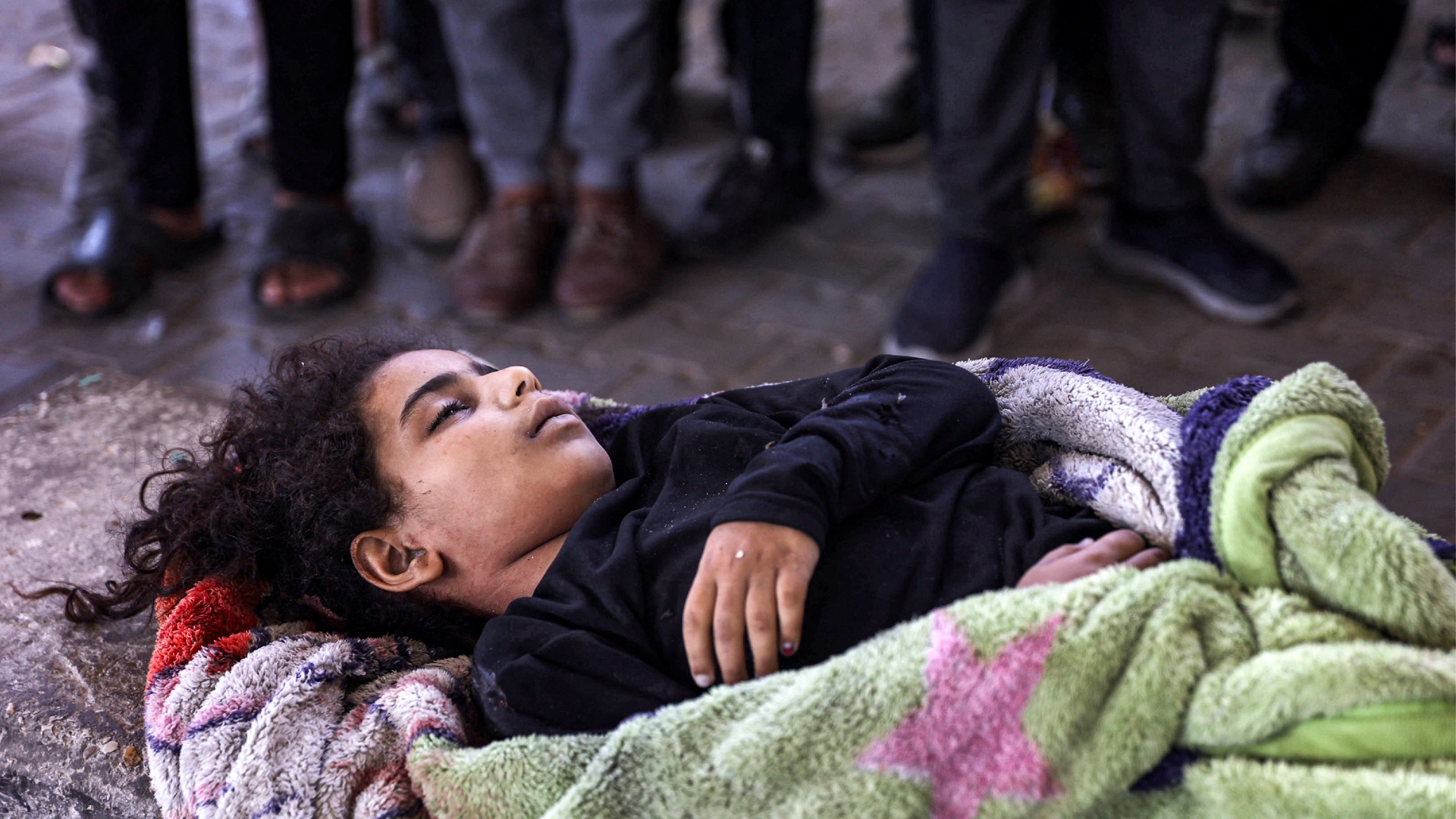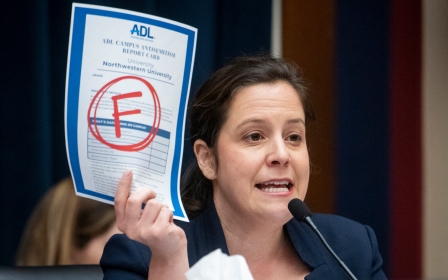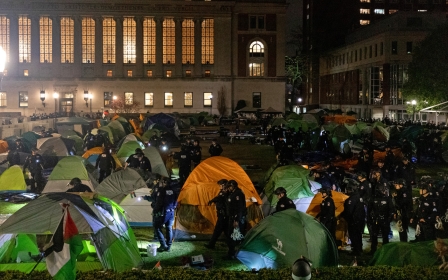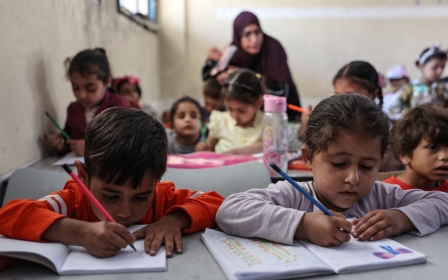War on Gaza: What does campus 'unsafety' mean in the midst of a genocide?

Last month, I woke up to the news that more than 90 Palestinians were killed when Israel bombed several sites in Gaza, including the Amal orphanage and school in the west of Gaza City.
The past year has been a relentless assault on all aspects of Palestinian life.
In addition to hospitals and places of worship, Israel has been targeting schools like Amal across Gaza in strikes that not only obliterate people seeking shelter after displacement but also destroy the infrastructure of life.
This destruction - which some call "scholasticide" - is one spoke in a multi-pronged genocidal wheel designed by Israel to wipe Gaza from the map.
New MEE newsletter: Jerusalem Dispatch
Sign up to get the latest insights and analysis on Israel-Palestine, alongside Turkey Unpacked and other MEE newsletters
Like so many people in the West, every day for over a year, I wake up to this news: more numbers, more names. More institutions decimated, and more land destroyed.
I fall asleep at night, afraid of what will greet me in the morning, and for all the people in Palestine who won't survive the night. It's incredibly difficult to know how many people have been killed and displaced by Israel's genocide over this past year.
While "official" numbers have hovered around 40,000 for months now, this official estimate is a gross undercount both because of indirect deaths and those who are missing under the rubble.
According to a July 2024 article in The Lancet, this number is too low because "in recent conflicts, such indirect deaths range from three to 15 times the number of direct deaths. Applying a conservative estimate of four indirect deaths per one direct death to the deaths reported, it is not implausible to estimate that up to 186,000 or even more deaths could be attributable to the current conflict in Gaza".
Now, four months later, the number is likely closer to 400,000.
Scholasticide
While Israel has been indiscriminately targeting civilians, it has also been targeting journalists, artists, academics, writers and students - anyone who is telling the story of Palestine. In doing so, they have both been targeting those who are currently telling this story and those who will do so in the future.
Israel has murdered thousands of teachers, students and academics. At least 625,000 schoolchildren are being denied an education. All of Gaza's 12 universities have been bombed and mostly destroyed. Approximately 477 primary and secondary schools have been destroyed or damaged.
These are not isolated incidents, but instead part of Israel's targeted attack not just on Gaza's present, but on its future. These numbers mean that Israel is destroying both the physical infrastructure of higher education in Gaza and its intellectual infrastructure.
Follow Middle East Eye's live coverage of the Israel-Palestine war
Nowhere in Gaza is safe.
This year of scholasticide is merely an accelerated form of destruction carried out by Israel against Palestinians in Gaza, as education in the strip has been under attack for decades.
Before this latest and brutal genocidal assault, Israel cut Gaza off from the occupied West Bank (and the world) through an indefinite blockade that began in 2007.
This meant that university students and academics in Gaza could not travel internationally to pursue educational opportunities. This not only put pressure on Gaza's universities, it also limited Palestinians in Gaza from pursuing speciality degrees and training.
Additionally, many school-aged children have not had access to necessary school supplies, as Israel often blocks the entry of such items into Gaza. Because of both limited supplies and limited resources, many children have been unable to afford these basic school supplies even when they are available.
Additionally, before 7 October 2023, Gaza did not have enough buildings to accommodate its population of school-aged children, as Israel's blockade has created conditions in which Palestinians in Gaza cannot access the materials necessary to build new schools.
Gaza was already reeling from Israel's 2014 attacks when 252 schools were damaged and seven destroyed. While most of these buildings were repaired and rebuilt, this constant destruction and rebuilding has put strain on students as well as resources.
Student 'unsafety'
Despite the material unsafety experienced by Palestinians in Gaza and the occupied West Bank (and now in Lebanon) because of Israel's accelerating genocide and ethnic cleansing, my year has been occupied with a different talk of "unsafety".
For over 12 months now, both liberal and far-right politicians and university administrators in the US - as well as in Canada and parts of Europe - have been preoccupied with talk of Jewish students' feelings of "unsafety".
In particular, I have been told I made some students, specifically Jewish Zionist students, feel "unsafe" because I taught about Palestine and told my students the truth about Israel's assault on Palestinian lives.
What do these feelings of "unsafety" mean in the midst of a genocide?
It's important to note that such talk of "unsafety" is limited to Jewish feelings, as I have seen virtually no attention paid to the very material reality of Palestinian, Muslim and Arab students in the US who have been made unsafe.
This includes students like Hisham Awartani, Kinnan Abdalhamid and Tahseen Ahmad, who were shot by a man in Burlington, Vermont, on 25 November 2023 for speaking Arabic and wearing keffiyehs. Awartani was left paralyzed from the waist down.
Silencing dissent
Numerous other students have been doxxed and attacked because they participated in pro-Palestine protests and actions.
By ignoring these stories and focusing on "feelings" of unsafety, politicians and university administrators co-opt antisemitism in order to silence dissent and manufacture consent for Israel's crimes against humanity.
In the US, colleges and universities have never been safe spaces because of both their history of violence in the past and the inequality that violence produces in the present.
Institutional wealth has only been possible because of extraction, whether through settler colonial land theft or enslaved labour through the trans-Atlantic slave trade.
Professoriates and administrations provided intellectual cover for this work, which is also the case in Israel. Such a history results in institutions of higher education that are racist, classist, misogynist, homophobic and transphobic (to name a few violences). They are also Zionist.
University administrators are denying our students the right to learn about an ongoing genocide, being funded and enabled by the US government
Classrooms are not safe spaces.
When I was a college professor, at the start of every semester, I would tell my students: "This classroom is not a 'safe' space. A classroom is a wildly uneven and unequal place, which impacts who can and does feel safe. If you feel 'safe' in a particular space, there is likely at least one person who doesn't feel safe on account of your perceived safety."
I tell my students to abandon the goal of a "safe" space and instead work collectively towards creating a "brave" space - a classroom where, despite our inequities, we can work towards an environment where we all take risks and are accountable and grapple with hard things.
Now, college and university administrators are telling students not to be brave.
They are weaponising antisemitism by equating it with anti-Zionism (as in the case at New York University or the college where I used to teach) and then using Title VI of the Civil Rights Act of 1964 to silence, suspend or terminate faculty, staff and students who refuse to be cowed by this false and dangerous conflation. In doing so, they are denying our students the right to learn about an ongoing genocide, being funded and enabled by the US government.
More than a year after Israel's genocidal war on Gaza, we must work to change this narrative around student "unsafety".
Scholasticide in Gaza is unsafety. The murder of thousands - likely hundreds of thousands - of Palestinian students in Gaza is unsafety. The violent attacks on Palestinian, Arab and Muslim students are unsafety.
American students have both the right and the responsibility to be brave enough to confront the reality of this genocide.
The views expressed in this article belong to the author and do not necessarily reflect the editorial policy of Middle East Eye.
Middle East Eye delivers independent and unrivalled coverage and analysis of the Middle East, North Africa and beyond. To learn more about republishing this content and the associated fees, please fill out this form. More about MEE can be found here.






